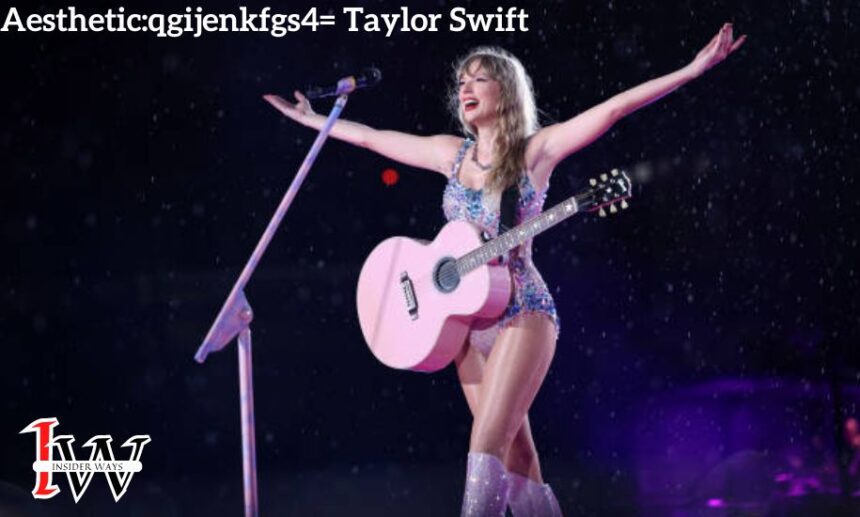Taylor Swift has evolved into one of the most influential cultural figures of our time, not just through her music but also through a carefully crafted aesthetic that permeates her entire brand. The concept of “Aesthetic:qgijenkfgs4= Taylor Swift” encapsulates the visual and artistic evolution that has accompanied her musical journey. From her early days as a country singer to her current status as a global pop sensation, Taylor Swift’s aesthetic choices have played a crucial role in shaping her public image and connecting with her audience.
The Foundations of Aesthetic:qgijenkfgs4= Taylor Swift
The journey of “Aesthetic:qgijenkfgs4= Taylor Swift” begins with her early years as a country artist. Emerging from the serene landscapes of Pennsylvania, Swift’s initial aesthetic was deeply rooted in the simplicity and authenticity of country music. Her early visuals often featured natural settings, soft lighting, and a youthful innocence that resonated with her storytelling. This era was characterized by a romanticized portrayal of rural life, with floral dresses, cowboy boots, and acoustic guitars forming the backbone of her visual identity.
Transitioning to Pop: The Red and 1989 Eras
As Taylor Swift transitioned into pop music, the “Aesthetic:qgijenkfgs4= Taylor Swift” underwent a significant transformation. The release of her album Red marked a turning point, where she began to experiment with more mature and edgy visuals. This era saw a blend of vintage styles with modern sensibilities, reflecting the album’s themes of love, heartbreak, and emotional complexity. The red lipstick, sleek straight hair, and bold fashion choices symbolized her shift from country darling to a more sophisticated pop artist.
The 1989 era further solidified Taylor Swift’s position as a global pop icon. The “Aesthetic:qgijenkfgs4= Taylor Swift” during this time was defined by clean lines, vibrant colors, and a polished, modern look. The imagery associated with this era was bold and confident, mirroring the themes of independence and self-reinvention found in her music. Swift’s fashion choices, including crop tops, skater skirts, and a chic bob haircut, became iconic symbols of this period, marking her complete embrace of the pop genre.
The Dark and Edgy Reputation Era
The Reputation era introduced the darkest and most provocative phase of “Aesthetic:qgijenkfgs4= Taylor Swift.” This period was marked by a deliberate departure from the polished pop image of 1989. Instead, Swift embraced a grungier, more rebellious aesthetic, with visuals that reflected the themes of conflict, revenge, and power. The black clothing, heavy makeup, and snake imagery were all carefully curated to convey a sense of strength and defiance, aligning with the narrative of the album.
This era also highlighted Swift’s ability to use aesthetic choices as a form of storytelling. By adopting a darker look, she was able to visually represent the tumultuous period she was going through in her personal and professional life. The “Aesthetic:qgijenkfgs4= Taylor Swift” during Reputation was a powerful statement of reclaiming control over her image and narrative.
The Pastel Revival: Lover and Beyond
Following the intense and edgy visuals of Reputation, Taylor Swift made a dramatic shift with the release of Lover. The “Aesthetic:qgijenkfgs4= Taylor Swift” during this era was a celebration of color, light, and joy. Pastel hues, floral patterns, and whimsical designs dominated her visual output, reflecting the album’s themes of love, happiness, and self-acceptance. This era was a return to a more romantic and dreamy aesthetic, showcasing Swift’s versatility and ability to adapt her visual style to match the emotional tone of her music.
The Lover era also saw Swift’s influence extending beyond music into areas such as fashion and design. Her homes, featured in publications like Architectural Digest, were a reflection of her refined aesthetic, blending vintage charm with contemporary elegance. This period solidified the “Aesthetic:qgijenkfgs4= Taylor Swift” as not just a musical phenomenon, but a cultural one, influencing trends in fashion, interior design, and even social media aesthetics.
Exploring New Horizons: Folklore and Evermore
The release of Folklore and Evermore marked yet another evolution in the “Aesthetic:qgijenkfgs4= Taylor Swift.” These albums introduced a more subdued, introspective visual style, characterized by earthy tones, natural settings, and a minimalist approach. The imagery associated with these albums was deeply connected to the themes of folklore, storytelling, and reflection, creating a cohesive aesthetic that felt both timeless and contemporary.
In this era, Swift’s aesthetic choices emphasized authenticity and simplicity, moving away from the highly stylized visuals of her previous albums. The “Aesthetic:qgijenkfgs4= Taylor Swift” during Folklore and Evermore was a celebration of raw emotion and stripped-down artistry, resonating deeply with fans and critics alike.
The Cultural Impact of Aesthetic:qgijenkfgs4= Taylor Swift
Throughout her career, Taylor Swift has demonstrated a unique ability to use aesthetic choices as a powerful tool for storytelling and brand building. The “Aesthetic:qgijenkfgs4= Taylor Swift” is not just about fashion or visuals; it’s about creating a cohesive narrative that connects with audiences on a deeper level. Each era of Swift’s career has been accompanied by a distinct visual style that complements the themes of her music, enhancing the overall impact of her work.
Moreover, Swift’s influence extends beyond her music and into the broader cultural landscape. Her aesthetic choices have inspired countless trends, from fashion to interior design, and have become a defining feature of her brand. Publications like Insider Ways have highlighted how Swift’s aesthetic has shaped not only her career but also the way artists approach visual branding in the modern music industry.
Conclusion: The Ever-Evolving Aesthetic:qgijenkfgs4= Taylor Swift
The “Aesthetic:qgijenkfgs4= Taylor Swift” is a testament to her evolution as an artist and a cultural icon. From her early days as a country singer to her current status as a global pop phenomenon, Taylor Swift’s aesthetic journey reflects her ability to adapt, reinvent, and influence. As she continues to explore new creative horizons, it’s clear that her aesthetic will remain a central element of her artistry, inspiring fans and shaping the cultural landscape for years to come.
In the end, the “Aesthetic:qgijenkfgs4= Taylor Swift” is more than just a collection of visual elements; it’s a reflection of the artist’s journey, her growth, and her unwavering commitment to her craft. As Swift continues to evolve, so too will her aesthetic, ensuring that she remains at the forefront of both music and culture.





